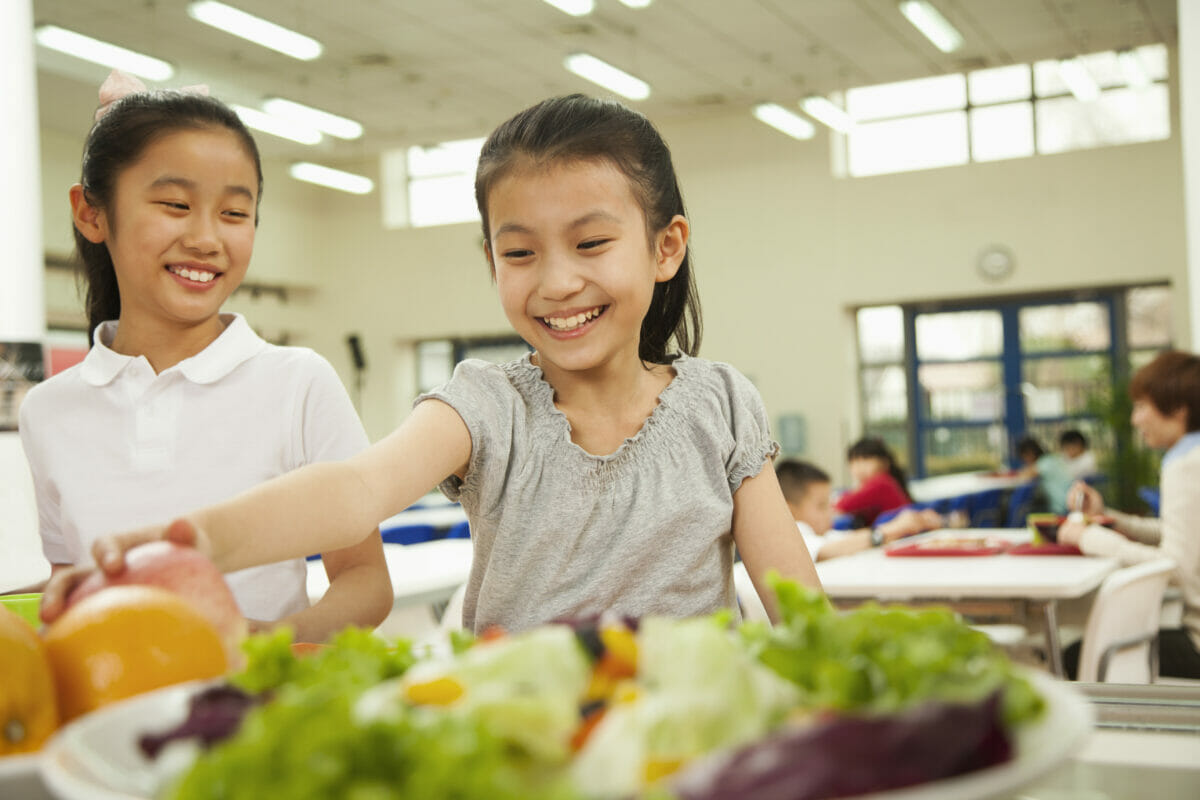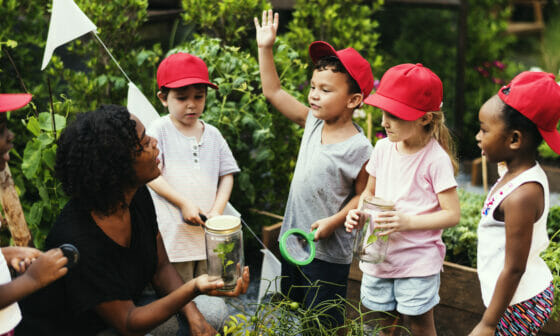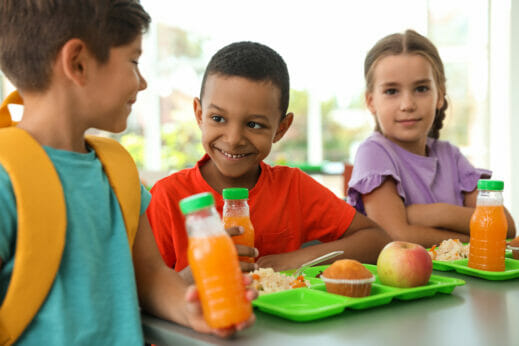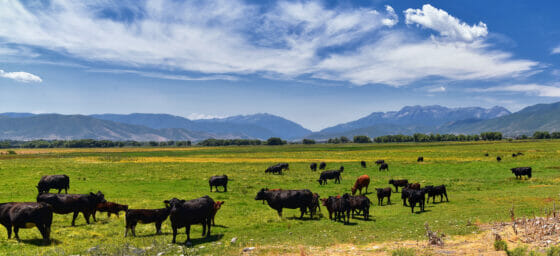States Want to Put More Local Food on School Lunch Trays. What Does That Mean, Exactly?
Local Food Purchasing Incentives are state programs that reimburse schools for buying locally. But first, states need to define what’s “local.”
States Want to Put More Local Food on School Lunch Trays. What Does That Mean, Exactly?
Local Food Purchasing Incentives are state programs that reimburse schools for buying locally. But first, states need to define what’s “local.”

Two children selecting lunch items.by Shutterstock.
In Utah, kids moving through the school cafeteria line at lunchtime can come across the Elliott apple, a yellow-gold fruit with a light blush of red. Discovered in-state and hard to get elsewhere, it’s a uniquely Utah product.
“It’s really fun when schools buy those apples and the kids get to learn about it,” says Kate Wheeler, Farm to Fork specialist for the Utah State Board of Education.
Elliott apples end up in state school lunches thanks to farm-to-school programs, initiatives that have expanded in the last few decades as a way to support children’s nutrition and regional agriculture. And it’s not just in Utah. With schools back in session, many school districts will be putting food from local farms on kids’ lunch trays. Farm-to-school programs can manifest in many different ways, but one pathway that has been increasingly adopted in recent years is Local Food Purchasing Incentives (LFPIs).
LFPIs are state-led programs allowing schools or early care programs to receive financial reimbursement for buying food from local producers. Buying local can be cost-prohibitive, so these types of programs are on the rise after calls for institutional support through state policy. Between 2001 and 2019, eight states and Washington, D.C. established programs across the country. Since the onset of the pandemic, seven additional states have adopted LFPI programs. These initiatives aim to increase local food purchasing for school meals, while providing children with nutritious food, strengthening local economies and helping school districts overcome cost barriers to local food.
No two of these programs are identical. But a question they all have to answer is what does “local” food mean, anyway?
Bespoke programs for states
In New York, School Food Authorities (nonprofits in charge of cafeterias) that spend 30 percent of their lunch budget on in-state food get an extra $0.19 cents back for every reimbursable lunch. Maine’s Local Foods Fund reimburses school districts with a dollar for every $3 spent on select local food, with a $5,000 cap for the school year—$5,500 if schools participate in a local foods training. Maine’s program began in 2001, but it received bolstered funding in 2019 and has been expanding and adjusting since then.

“It’s a constant evolution,” Robin Kerber, implementation manager for Full Plates Full Potential, an organization addressing food insecurity for children in Maine, said in a recent webinar hosted by the National Farm to School Network and Michigan State University’s Center for Regional Food Systems. “Every year, we’re reassessing what’s working, what’s not working, because we want it to work for everybody.”
This growing tide of LFPIs includes overlaps with other farm-to-school initiatives. One program distributes USDA funds to states to buy local food for schools. Additionally, some states are embracing a universal school meal model, wherein all kids eat for free at school, regardless of family income. Some of these include incentives for local food purchasing. This fall, students in Minnesota are experiencing the results of a universal meal policy for the first time.
“If there’s anything I can share, it’s that each incentive program is uniquely designed and administered,” says Cassandra Bull, policy consultant and host of the webinar series.
What is “local” food?
In practice, “local” is hard to define. Utah, for example, considers local to be anything Utah-grown. Wheeler says this approach isn’t without nuance. For example, schools can be reimbursed for Utah-made sour cream and cheese, but in the processing plants, milk from across state lines gets blended together to make these products. Utah counts these products as local as long as the product is made with 50 percent Utah-sourced milk.
“The other piece that we’ve struggled with a little bit is, is local a value in and of itself?” says Wheeler. “Or do we want to be promoting specific types of values-based procurements where we’re looking at how the food is produced and how it’s grown and worker treatment and all of those other values that sometimes we associate with “local” but aren’t necessarily inherently part of just buying something that’s close to you.”
But while big western states can equate “local” with “in-state,” things get trickier in the smaller states. New Hampshire is currently in the process of trying to pass a bill to support an LFPI. But only seven percent of New Hampshire is agricultural land, and many of the farms that it does have are dedicated to growing trees or hay.

Eight of New Hampshire’s 10 counties border other states or Canada, and Stacey Purslow, program coordinator for the New Hampshire Farm to School Program within the University of New Hampshire Sustainability Institute, says three of their school districts have students that live in one state and go to school in another. What this means is that the definition of “local” is going to be different than “from New Hampshire.”
“We don’t grow that much here, and we have cross-state school districts,” says Purslow. “So, we wanted to support New England agriculture as well.”
Conor Floyd, grant programs manager for Child Nutrition Programs in the Vermont Agency of Education, acknowledges that defining local food is not cut and dry.
“One really thorny issue for us in our process was, what counts as local?” says Floyd. Vermont uses a definition created by the state legislature. Beyond having a succinct definition, there’s also the matter of enforcement. “The question for me was, who’s checking to make sure that this is local or not?”
Tracking local purchases
In order to be compensated, schools need to keep track of local purchases. This can be tedious, but it can provide an accurate picture of local procurement in the state and show farmers what schools are buying.
In Utah, schools have a tracking spreadsheet to use throughout the year. If they don’t keep track along the way, it can result in confusion and difficulty when it comes time to submit, says Wheeler.
“Some of our folks who are buying local are also not submitting for reimbursement because they feel like it’s too much work,” says Wheeler.
Harvest New York, an organization that helps grow the farm and food economy in New York state, created a database to help School Food Authorities track down qualifying products and get the paperwork they need.
“We need to make sure that the products are actually from New York, but the paperwork can’t be so onerous that our school food authorities don’t want to participate in it,” says Cheryl Bilinksi, local food systems specialist and Farm to School lead at Harvest New York.

For Wheeler, the success stories keep her going. New this year, Utah have established cooperative contracts with seven ranchers across the state. Every school in the state can order and be reimbursed funds for local beef or bison.
“The ranchers are so excited, and the schools are so excited,” says Wheeler. “Just seeing something work makes you realize it can continue to work, and that’s definitely one of the things that keeps you going.”
Follow us
This work is licensed under a Creative Commons Attribution-NoDerivatives 4.0 International License.
Want to republish a Modern Farmer story?
We are happy for Modern Farmer stories to be shared, and encourage you to republish our articles for your audience. When doing so, we ask that you follow these guidelines:
Please credit us and our writers
For the author byline, please use “Author Name, Modern Farmer.” At the top of our stories, if on the web, please include this text and link: “This story was originally published by Modern Farmer.”
Please make sure to include a link back to either our home page or the article URL.
At the bottom of the story, please include the following text:
“Modern Farmer is a nonprofit initiative dedicated to raising awareness and catalyzing action at the intersection of food, agriculture, and society. Read more at <link>Modern Farmer</link>.”
Use our widget
We’d like to be able to track our stories, so we ask that if you republish our content, you do so using our widget (located on the left hand side of the article). The HTML code has a built-in tracker that tells us the data and domain where the story was published, as well as view counts.
Check the image requirements
It’s your responsibility to confirm you're licensed to republish images in our articles. Some images, such as those from commercial providers, don't allow their images to be republished without permission or payment. Copyright terms are generally listed in the image caption and attribution. You are welcome to omit our images or substitute with your own. Charts and interactive graphics follow the same rules.
Don’t change too much. Or, ask us first.
Articles must be republished in their entirety. It’s okay to change references to time (“today” to “yesterday”) or location (“Iowa City, IA” to “here”). But please keep everything else the same.
If you feel strongly that a more material edit needs to be made, get in touch with us at [email protected]. We’re happy to discuss it with the original author, but we must have prior approval for changes before publication.
Special cases
Extracts. You may run the first few lines or paragraphs of the article and then say: “Read the full article at Modern Farmer” with a link back to the original article.
Quotes. You may quote authors provided you include a link back to the article URL.
Translations. These require writer approval. To inquire about translation of a Modern Farmer article, contact us at [email protected]
Signed consent / copyright release forms. These are not required, provided you are following these guidelines.
Print. Articles can be republished in print under these same rules, with the exception that you do not need to include the links.
Tag us
When sharing the story on social media, please tag us using the following: - Twitter (@ModFarm) - Facebook (@ModernFarmerMedia) - Instagram (@modfarm)
Use our content respectfully
Modern Farmer is a nonprofit and as such we share our content for free and in good faith in order to reach new audiences. Respectfully,
No selling ads against our stories. It’s okay to put our stories on pages with ads.
Don’t republish our material wholesale, or automatically; you need to select stories to be republished individually.
You have no rights to sell, license, syndicate, or otherwise represent yourself as the authorized owner of our material to any third parties. This means that you cannot actively publish or submit our work for syndication to third party platforms or apps like Apple News or Google News. We understand that publishers cannot fully control when certain third parties automatically summarize or crawl content from publishers’ own sites.
Keep in touch
We want to hear from you if you love Modern Farmer content, have a collaboration idea, or anything else to share. As a nonprofit outlet, we work in service of our community and are always open to comments, feedback, and ideas. Contact us at [email protected].by Lena Beck, Modern Farmer
September 22, 2023
Modern Farmer Weekly
Solutions Hub
Innovations, ideas and inspiration. Actionable solutions for a resilient food system.
ExploreShare With Us
We want to hear from Modern Farmer readers who have thoughtful commentary, actionable solutions, or helpful ideas to share.
SubmitNecessary cookies are absolutely essential for the website to function properly. This category only includes cookies that ensures basic functionalities and security features of the website. These cookies do not store any personal information.
Any cookies that may not be particularly necessary for the website to function and are used specifically to collect user personal data via analytics, ads, other embedded contents are termed as non-necessary cookies.
An admirable effort. One problem however, at least in the Northern half of the country is: When are kids in school?: September – June. When do farmers harvest produce?: June-September. There is a seasonality problem at least for fruits and vegetables.
Great way to teach students about meaningless gestures.